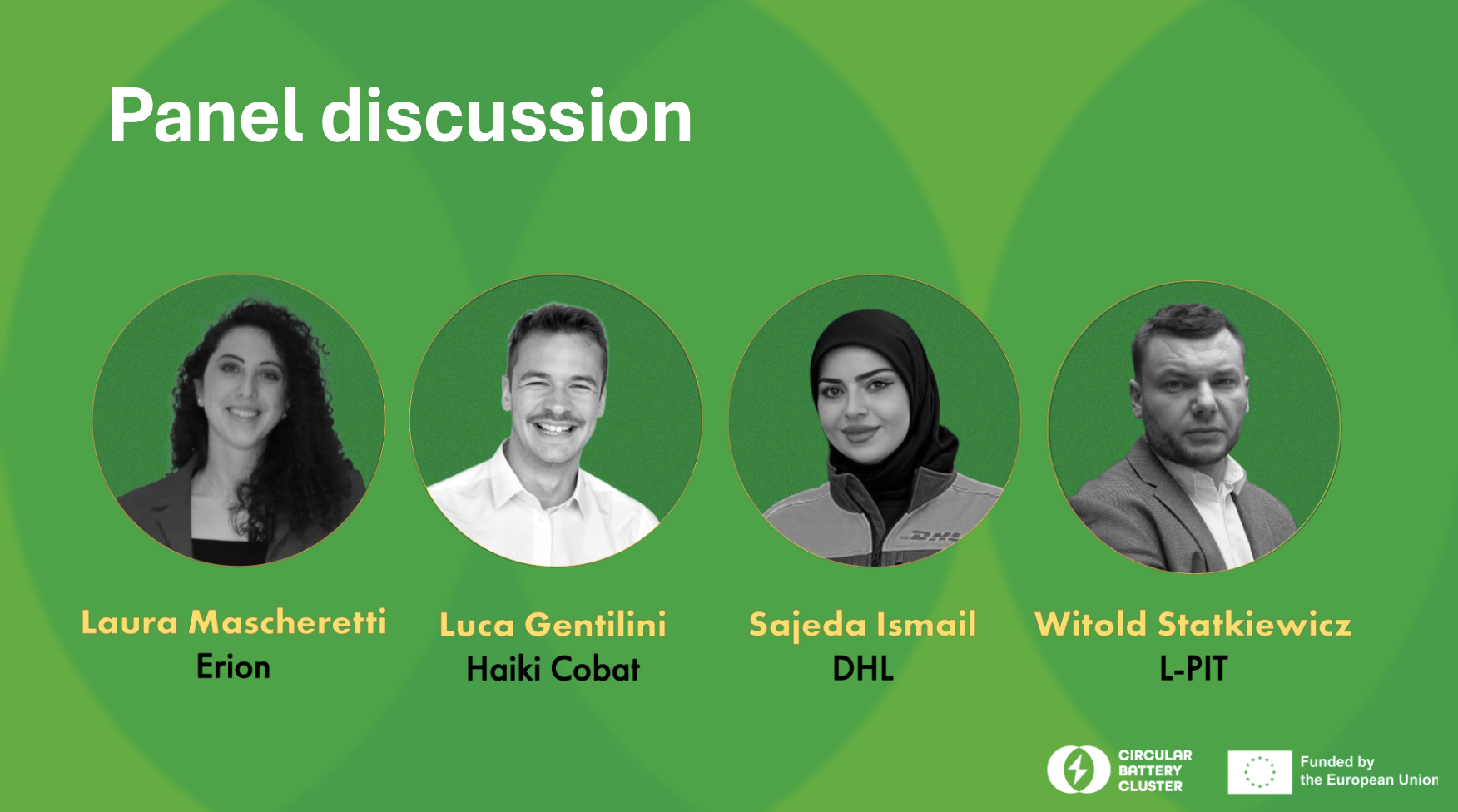Hosted by the Circular Battery Cluster, “Closing the Loop: Reverse Logistics for Batteries in Europe,” brought together industry experts to discuss one of the most pressing questions facing the battery ecosystem today: How do we build an efficient, scalable, and truly circular reverse logistics chain for end-of-life EV batteries?
Drawing insights from BatteReverse and fellow EU-funded battery circularity projects REBELION, REINFORCE, and RECIRCULATE, the panel - moderated by Maarten Buysse from Bax Innovation - highlighted both the challenges and solutions emerging across Europe.
Panellists included:
- Laura Mascheretti, Strategic Development & Innovation Expert, Erion
- Luca Gentilini, R&D Leader, Haiki Cobat
- Sajeda Ismail, EVB Network Manager, DHL
- Witold Statkiewicz, Business Analyst, Łukasiewicz – Poznań Institute of Technology
Together, they drew a clear picture of where we stand today and what needs to happen next.
1. The cost challenge: why scale matters
One message came through loud and clear: reverse logistics is still too expensive. Low volumes, scattered collection points, and long-distance transport drive up costs dramatically. Europe also lacks a dense network of recycling and pre-treatment facilities, meaning batteries often travel hundreds of kilometres before reaching the right destination.
This fragmentation also leads to significant value loss. An estimated 30–50% of batteries never make it back into the circular system, which is a missed opportunity in terms of materials, business value, and sustainability impact.
The panellists agreed on a key solution, which is to establish local pre-treatment plants. By processing large, hazardous battery packs into black mass closer to where they’re collected, the industry can reduce transport risks, cut costs, and build the volume needed to scale recycling operations.
2. Regulation: essential for market development, but operationally demanding
EU regulations, especially the new Battery Regulation, are essential for pushing the market towards circularity. They bring clarity, set expectations, and create the conditions for investment.
But the regulatory reality is still challenging. For example, the cross-border notification process for hazardous waste remains slow and burdensome, making it hard to keep pace with the rapid rise in EVs.
Panel experts expect that, as volumes increase, administrative processes will need to evolve to keep up. They also warned that if the requirements are not well balanced, for example, if recycled content targets are set too high, the industry could face unintended consequences, such as dismantling batteries too early just to comply.
3. Safety, standardisation and the Digital Battery Passport
From a technical standpoint, safety remains a top priority. Today, there is no unified approach to battery diagnostics or cut-off criteria. Manufacturers use different methods to evaluate a battery’s State of Health (SoH), making it difficult to determine whether a unit should be reused, repurposed, or recycled.
Here, the Digital Battery Passport (DPP) is expected to be a game-changer. By providing verified, accurate, and accessible data across the entire value chain, the DPP will:
- Make diagnostics more reliable
- Enable correct channelling (reuse, repurpose, recycle)
- Reduce uncertainty in logistics
- Improve safety and compliance
Logistics providers confirmed that better access to data simplifies their work, as long as companies are willing to digitise their current manual processes. They also emphasised that even with improved diagnostics, strong safety procedures and legally compliant transport/storage solutions must remain essential because better data does not eliminate the inherent risks of handling used lithium-ion batteries.
What it takes to truly close the loop
Building a circular battery ecosystem in Europe won’t happen through one solution alone. It requires a coordinated, industry-wide effort focused on three essential pillars:
- Investing in decentralised pre-treatment capacity to reduce costs and manage volumes efficiently.
- Harmonising technical and safety standards to ensure consistent, reliable battery diagnostics and handling.
- Leveraging the Digital Battery Passport to enable full traceability and trustworthy data throughout the reverse logistics chain.
Circularity is not just an environmental priority but also a strategic pathway to strengthening Europe’s battery value chain. And as projects across Europe continue to pilot real-world solutions, one thing is clear: with the right mix of infrastructure, regulation, and digitalisation, the industry can finally close the loop on Europe’s growing EV battery fleet.
You can rewatch the recording of the session on the Battereverse Community platform.
What are your thoughts? We'd love to hear from you. Feel free to contact us.



